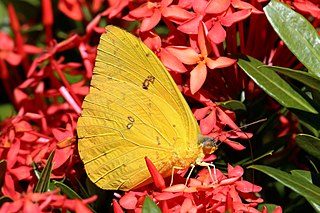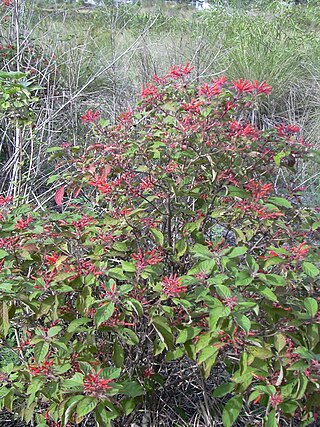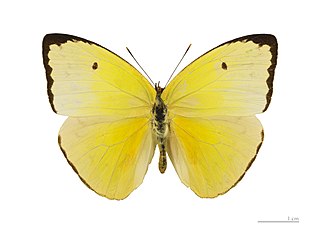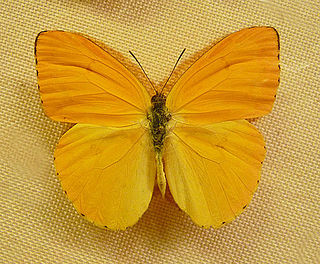
Phoebis sennae, the cloudless sulphur, is a mid-sized butterfly in the family Pieridae found in the Americas. There are several similar species such as the yellow angled-sulphur, which has angled wings, statira sulphur, and other sulphurs, which are much smaller. The species name comes from the genus Senna to which many of the larval host plants belong.

Coliadinae, the sulphurs or yellows, are a subfamily of butterflies with about 300 described species.

Hamelia patens is a large perennial shrub or small tree in the family Rubiaceae, that is native to the American subtropics and tropics. Its range extends from Florida in the southern United States to as far south as Argentina. Common names include firebush, hummingbird bush, scarlet bush, and redhead. In Belize, this plant's Mayan name is Ix Canaan and is also known as "Guardian of the Forest".

Nathalis iole, the dainty sulphur or dwarf yellow, is a North American butterfly in the family Pieridae.

Phoebis, or sulphurs, is a genus of butterflies, belonging to the subfamily Coliadinae of the "whites" or family Pieridae. They are native to the Americas.

Senna marilandica, commonly known as Maryland senna, Maryland wild senna, and wild senna, is a perennial flowering plant in the pea family (Fabaceae) native to the United States. It blooms in the summer with yellow flowers, followed by long seed pods, and can grow up to 2 m (6 ft) tall. It prefers average to wet soil.

Kricogonia lyside, the lyside sulphur or guayacan sulphur, is a North American, Caribbean, and South American butterfly in the family Pieridae.

Aphrissa statira, the statira sulphur, is a species of Lepidoptera in the family Pieridae. The species is a medium-sized yellow butterfly, with females more pale than males. They are found from southern regions of Florida and Texas through southern Brazil and northern Argentina. The caterpillars feed on the leaves of several local host plants, while adults prefer to feed on the nectar of red or orange colored flowers. The species is most noted for their dramatic migrations in the tropical areas of the Americas. They have been the subject of many studies about how butterflies navigate and orient during migration.

Aphrissa is a genus of butterflies in the family Pieridae found in Central and South America.

Phoebis agarithe, the large orange sulphur, is a butterfly in the family Pieridae. It is found from Peru north to southern Texas and peninsular Florida. Rare strays can be found up to Colorado, South Dakota, Wisconsin, and New Jersey. The species has also been introduced in Hawaii. The habitat consists of open, tropical lowlands including gardens, pastures, road edges, trails and parks.

Aphrissa orbis, the orbed sulphur, is a butterfly in the family Pieridae. It is native to Hispaniola and Cuba but is a very rare stray to Florida. The habitat consists of tropical moist forests above 500 meters.

Rhabdodryas is a genus of butterflies in the family Pieridae. The only species is the straight-line sulphur.

Phoebis argante, the apricot sulphur or Argante giant sulphur, is a butterfly in the family Pieridae.
















